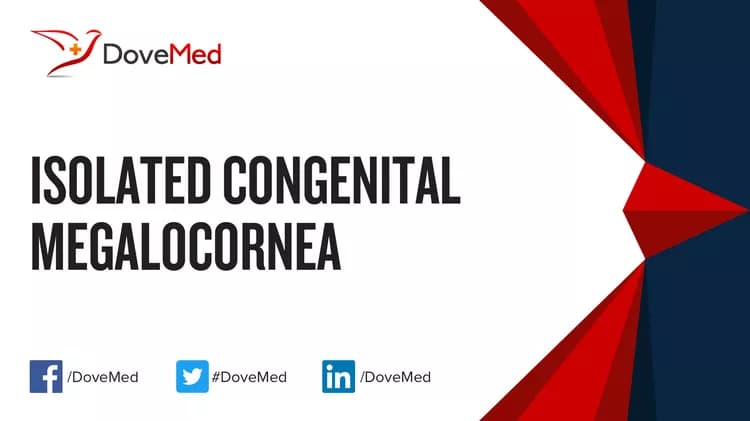What are the other Names for this Condition? (Also known as/Synonyms)
- Congenital Anterior Megalophthalmia
- MGC1 (Megalocornea)
- MGCN (Megalocornea)
What is Isolated Congenital Megalocornea? (Definition/Background Information)
- Isolated Congenital Megalocornea is an inherited eye disorder in which the cornea of the eye is enlarged from birth. The cornea in both eyes is greater than 13 mm wide, and it is not due to an increase in eye pressure
- Features of Megalocornea include astigmatism, decreased iris pigment (atrophy of the iris stroma), contraction of the pupil (miosis), iris tremors (iridodonesis), and dislocation of the lens
- Most people with Megalocornea have normal eye function, although some people can develop cataracts or glaucoma
- In about 90 percent of cases, the condition is inherited in an X-linked recessive pattern
- Treatment may include correcting vision with eyeglasses or contact lenses and regular exams to check for cataracts and glaucoma
(Source: Isolated Congenital Megalocornea; Genetic and Rare Disease Information Center (GARD) of National Center for Advancing Translational Science (NCATS), USA.)
Who gets Isolated Congenital Megalocornea? (Age and Sex Distribution)
- Isolated Congenital Megalocornea is a rare congenital disorder. The presentation of symptoms may occur at any age
- The condition predominantly affects males
- Worldwide, individuals of all racial and ethnic groups may be affected
What are the Risk Factors for Isolated Congenital Megalocornea? (Predisposing Factors)
- A positive family history may be an important risk factor, since Isolated Congenital Megalocornea can be inherited
- Currently, no other risk factors have been clearly identified for this condition
It is important to note that having a risk factor does not mean that one will get the condition. A risk factor increases one’s chances of getting a condition compared to an individual without the risk factors. Some risk factors are more important than others.
Also, not having a risk factor does not mean that an individual will not get the condition. It is always important to discuss the effect of risk factors with your healthcare provider.
What are the Causes of Isolated Congenital Megalocornea? (Etiology)
- Isolated Congenital Megalocornea is caused by mutation(s) in the CHRDL1 gene, located on the X chromosome
- The disorder is inherited in an X-linked recessive manner
X-linked recessive mode of inheritance: The gene associated with this condition is located on the X chromosome, which is one of the two sex chromosomes. In males (who have only one X chromosome), one altered copy of the gene in each cell is sufficient to cause the condition. In females (who have two X chromosomes), a mutation would have to occur in both copies of the gene to cause the disorder. Because it is unlikely that females will have two altered copies of this gene, males are affected by X-linked recessive disorders much more frequently than females. A characteristic of X-linked inheritance is that fathers cannot pass X-linked traits to their sons.
What are the Signs and Symptoms of Isolated Congenital Megalocornea?
The signs and symptoms of Isolated Congenital Megalocornea may vary among affected individuals in type and severity, and include:
- Astigmatism
- Cataract
- Corneal arcus
- Increased corneal thickness
- Iridodonesis
- Lens subluxation
- Megalocornea
- Mosaic corneal dystrophy
(Source: Isolated Congenital Megalocornea; Genetic and Rare Disease Information Center (GARD) of National Center for Advancing Translational Science (NCATS), USA.)
How is Isolated Congenital Megalocornea Diagnosed?
Isolated Congenital Megalocornea is diagnosed on the basis of the following information:
- Complete physical examination
- Thorough medical history evaluation
- Assessment of signs and symptoms
- Vision tests and eye examinations
- Laboratory tests
- Imaging studies
- Biopsy studies, if necessary
Many clinical conditions may have similar signs and symptoms. Your healthcare provider may perform additional tests to rule out other clinical conditions to arrive at a definitive diagnosis.
What are the possible Complications of Isolated Congenital Megalocornea?
The complications of Isolated Congenital Megalocornea may include:
- Lens dislocation
- Retinal detachment
- Glaucoma
- Cataract at an early age
Complications may occur with or without treatment, and in some cases, due to treatment also.
How is Isolated Congenital Megalocornea Treated?
There is no cure for Isolated Congenital Megalocornea, since it is a genetic condition. The treatment is usually given to manage the signs and symptoms and any complication that develops. The treatment methods may include:
- Use of corrective lenses
- Surgery
How can Isolated Congenital Megalocornea be Prevented?
Isolated Congenital Megalocornea may not be preventable, since it is a genetic disorder.
- Genetic testing of the expecting parents (and related family members) and prenatal diagnosis (molecular testing of the fetus during pregnancy), if available, may help in understanding the risks better during pregnancy
- If there is a family history of the condition, then genetic counseling will help assess risks, before planning for a child
- Active research is currently being performed to explore the possibilities for treatment and prevention of inherited and acquired genetic disorders
Regular medical screening at periodic intervals with tests and physical examinations are recommended.
What is the Prognosis of Isolated Congenital Megalocornea? (Outcomes/Resolutions)
- The prognosis of Isolated Congenital Megalocornea is dependent upon the severity of the signs and symptoms and associated complications, if any
- Individuals with mild conditions have better prognosis than those with severe symptoms and complications
- Typically, the prognosis may be assessed on a case-by-case basis
Additional and Relevant Useful Information for Isolated Congenital Megalocornea:
The following DoveMed website link is a useful resource for additional information:
Related Articles
Test Your Knowledge
Asked by users
Related Centers
Related Specialties
Related Physicians
Related Procedures
Related Resources
Join DoveHubs
and connect with fellow professionals


0 Comments
Please log in to post a comment.